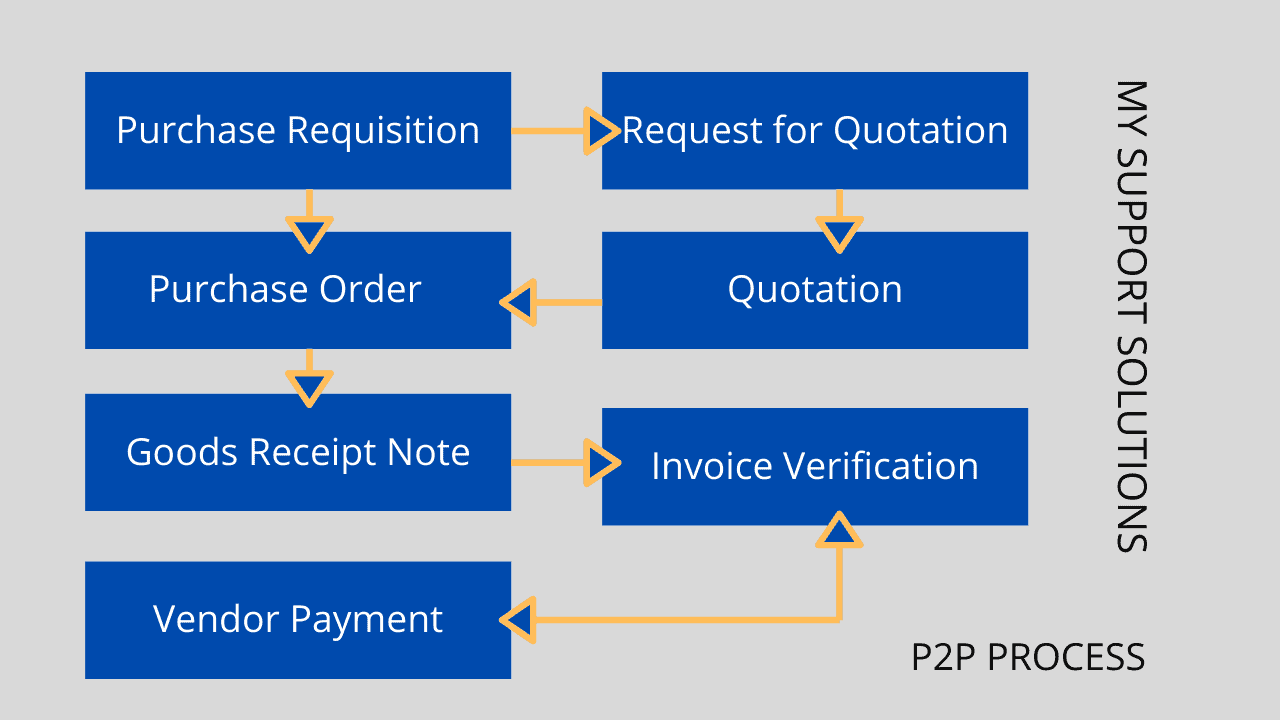SAP P2P PROCESS (PROCURE TO PAY PROCESS)
SAP P2P Process (P2P process in SAP or procure to pay process) is essential for purchasing activities in a company. We will observe in viewpoint of SAP MM. It is essential and useful to buying of material or service and it is essential for the smooth functioning of a department.
It can be also termed in different ways like :
- Procurement Cycle
- Source to Pay
- Procure to Pay

PURCHASE REQUISITION(PR)
Purchase requisition is internal document i.e. within company. No external stakeholder or third party is involved in this. It is demand for a certain kind of material for a specified quantity to fulfill the requirements within time.
We can raise PR for the following procurement types:
- Standard
- Subcontracting
- Consignment
- Stock Transfer
- External Service
REQUEST FOR QUOTATION(RFQ)
Once we gather all the requirements, purchasing department will send request to all the prospective vendors for the said material who can fulfill the requirement at best possible price. This is called as RFQ. Vendor sends a reply against RFQ which is called as Quotation.
RFQ can be created by two different ways:
-
- Manually
- With reference to PR
QUOTATION
Vendor in response to RFQ which is send by company purchasing department sends information regarding Price and other related factors. This is called as Quotation. We have to maintain Quotation in our system by following the transaction code ME47.
When we received multiple quotations from vendors we have to compare all these by following transaction code ME49 for the best available quotation.
PURCHASE ORDER
This is important stage of P2P Process.A Purchase Order is formal and legal document asking vendor to supply certain quantity of material at specified price to respective plant within time limit. Purchase Order can be raised not only for procurement of material but also for services. Purchase Orders can be raised with or without reference of Purchase Requisition.
When PO is raised for procurement of stock material ( T Code: ME21N), one must have to specify the material number( which is created in Material Master).
PO can also be raised for the procurement of direct consumable material. For example, if anyone procures material for a specific project or work that material is treated as consumed on receipt, hence inventory not gets updated in such cases. We have to mention account assignment in PO for proper effect to cost object.
If you are ease at watching a video, below is the same:
PURCHASE ORDER TYPES
SAP provides many Purchase Order types. User gets different screens for each type of PO.
- FRAMEWORK ORDER
If anyone wants to buy product which has very small value, Blanket Purchase Order has to be raised for the specific maximum value and validity period, with document type FO and item category Limit.
- STOCK TRANSPORT ORDER(STO)
Sometimes company dispatches material from one plant to another Plant. It is called as STO. This can be done by using document type as UB for created a purchase order called Stock transport order.
GOODS RECEIPT NOTE
It is a confirmation that vendor has dispatched material which were mentioned in PO at the specific Plant. ( Refer Enterprise Structure). User has to follow MIGO t code for GRN.
There is certain procedure or steps involved in GR:
- Company sends PO to Vendor
- Vendor dispatches material at plant mentioned in PO, may be full or partial quantity
- Goods Receipt at plant
- At time of GRN system generates document as a proof of GR and accordingly accounting document also gets generated.
LOGISTICS INVOICE VERIFICATION
It is a part of SAP MM and closely integrated with other functional modules like FI and CO. It is also associated with Empties Management where one can track movement and stock of reusable packaging.
It completes the process of material procurement and also allows for credit memos for return deliveries or invoice reversal. We can follow MIRO T code for invoice verification.
There are various ways to process invoice in Invoice verification like:
- Document Parking
- Automatic Settlements
- Invoice Received via EDI etc.
Ideally with view point of materials management this is the last stage of SAP P2P Process.
VENDOR PAYMENT
Every company needs to pay its vendors once material is received at plant. Often, payments are made against invoice and posted to vendor accounts.
Like invoice verification there are several ways to pay vendor:
- Cash . ( Follow FBCJ t code)
- Cheque
- Manual Electronic Transfer ( Follow F-53 )
- File Electronic Transfer
- Letter of Credit
Ideally, for viewpoint of Materials Management SAP P2P Process will end at the stage of Logistics Invoice Verification.
Our other posts :If you like this tutorial please share our content.